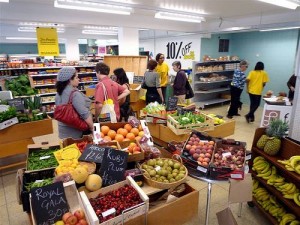With the progression of internet activism, it is important to acknowledge the various means of protest as powerful forms in their own right. Blogging has had considerable effects on activist movements globally, either by protesting against events or by actively raising awareness to an issue and therefore being an activist. A 2006 study from the Pew Internet & American Life Project found 39% of American Internet users read blogs and that 8% of American have blogs of their own: (Lenhart and Fox, 2006) a figure which has sure to have increased 7 years later.
One well renowned example of how blogging can create awareness is that of Paul Frank and their fourth year ‘Fashion Night out’ in September 2012. What was supposed to be a ‘fun’ and ‘fashionable’ night out for the people of West Hollywood, resulted in gaining attention for all the wrong reasons, (Native Appropriations, 2013). Titled “Dream Catchin’ with Paul Frank” a “pow wow celebrating Fashion’s Night Out,” the evening featured Julius the monkey motif sporting a feathered headdress. Amongst the 1000 photographs uploaded onto their Facebook page were snaps of plastic bows and arrows and plastic neon tomahawks. Not only that, there were 3 themed drinks entitled, ‘Rain Dance Refresher,’ ‘Dream Catcher’ and ‘Neon Teepee.’ Adrienne Keene author of the blog ‘Native Appropriations,’ wrote to Paul Frank after noticing the re-post of photos on Jessica Metcalfe’s Facebook (the author of ‘Beyond Buckskin.’) Paul Frank didn’t see the letter first through their PR but through the recognition and attention the letter was receiving on the blog itself.
Their response could not have been more unexpected. Following Paul Frank’s standard apology on Facebook, their president Elie Dekel got in contact with Adrienne giving his sincerest apologies and taking full responsibilities. They then removed all their Native imagery designs online and from their Style Guide as well as contacting the manufacturers. But not only this, Paul Frank Industries are collaborating with a Native artist to make new designs, with all the resultant proceeds being donated to a Native cause.
Another similar case with a rather contrasting outcome was in 2011 involving the clothing line Urban Outfitters and their promotion of the line Navajo. It was brought to attention by Sasha Houston Brown on the blog site ‘Racialicious,’ (2011) describing the line as if “Ke$ha had violently exploded in the store, leaving behind a cheap, vulgar and culturally offensive retail collection.” The store in Minneapolis featured plastic dreamcatchers wrapped in pleather next to artificial feather jewellery and masses of clothing with inauthentic tribal patterns including the ‘Navajo Hipster Panty.’ The company’s choice to include the term Navajo also violated the Federal Indian Arts and Crafts act of 1990 and the Federal Trade Commission Act. The lawsuit issued last year sought for monetary compensation and an order permanently permitting Urban Outfitters from using the name “Navajo” or variations. Company spokesman Ed Looram said “The Native American-inspired trend and specifically the term ‘Navajo’ have been cycling thru fashion, fine art and design for the last few years,” (Guardian, 2012). The case is still continuing as of April this year, with all of the products now removed of the ‘Navajo’ branding (Indian Nation, 2013).
Though my previous blog questioned the future of the internet in terms of sustainability, above is a prime example of how effective an online community can be in achieving justice. De Zúñiga et al (2007) encourage the participation of blog users, hoping it will encourage engagement of the public and a greater functioning democracy. Blogs themselves depict certain viewpoints and are selective of their content, a very ‘subtle’ form of activism. So when an active, passionate and powerful online group comes together, community mobilisation can achieve great things.
References
De Zúñiga, H.G., Veenstra, A.S., Vraga, E.K., Wang, M., Deshano, C.L., Perlmutter, D.D. and Shah, D.V. (2007) Online and Offline Activism: Communication Mediation and Political Messaging Among Blog Readers.
Guardian (2012) Navajo Nation sues Urban Outfitters for trademark infringement http://www.guardian.co.uk/world/2012/mar/01/navajo-nation-sues-urban-outfitters (accessed 22nd April 2013).
Indian Nation (2013) Judge: Urban Outfitters Case Can Continue
http://indiancountrytodaymedianetwork.com/2013/04/03/judge-urban-outfitters-case-can-continue-148520 (accessed 23rd April 2013).
Lenhart, A. and Fox, S. (2006) Bloggers: A portrait of the Internet’s new storytellers. Pew Internet & American Life Project
Native Appropriations (2013) Paul Frank offends every Native person on the planet with Fashion Night Out “Dream Catchin’ Pow wow” http://nativeappropriations.com/2012/09/paul-frank-offends-every-native-person-on-the-planet-with-fashion-night-out-dream-catchin-pow-wow.html (accessed 4th May 2013).
Native Appropriations (2013) Paul Frank Powwow Party Update: Am I dreaming? http://nativeappropriations.com/2012/09/paul-frank-powwow-party-update-am-i-dreaming.html (accessed 2nd May 2013).
Racialicious (2011) An Open Letter to Urban Outfitters on Columbus Day http://www.racialicious.com/2011/10/10/an-open-letter-to-urban-outfitters-on-columbus-day/ (accessed 25th April 2013).


